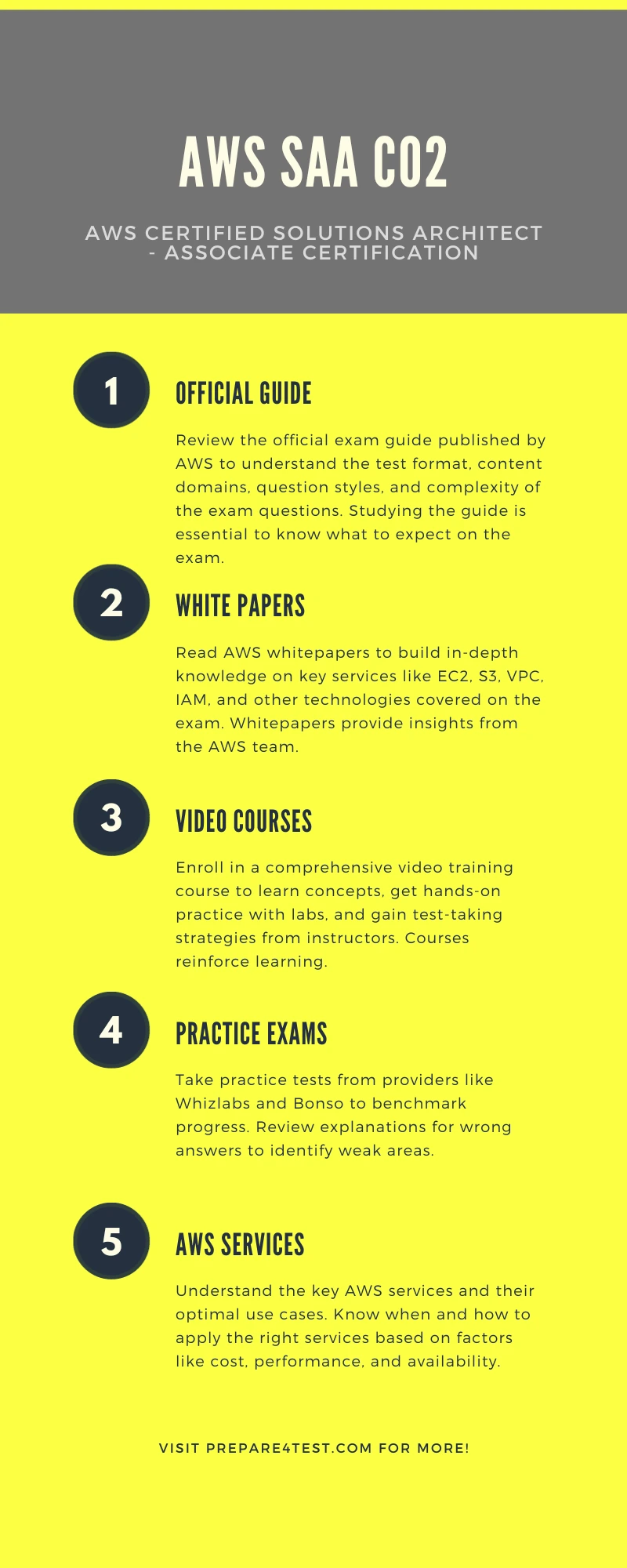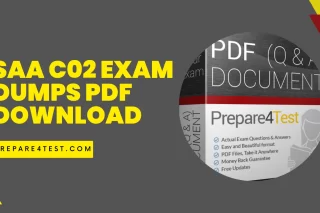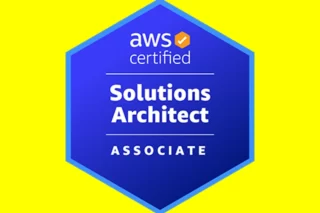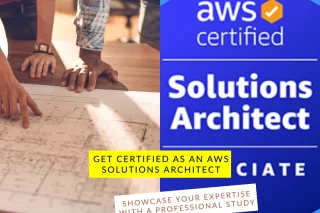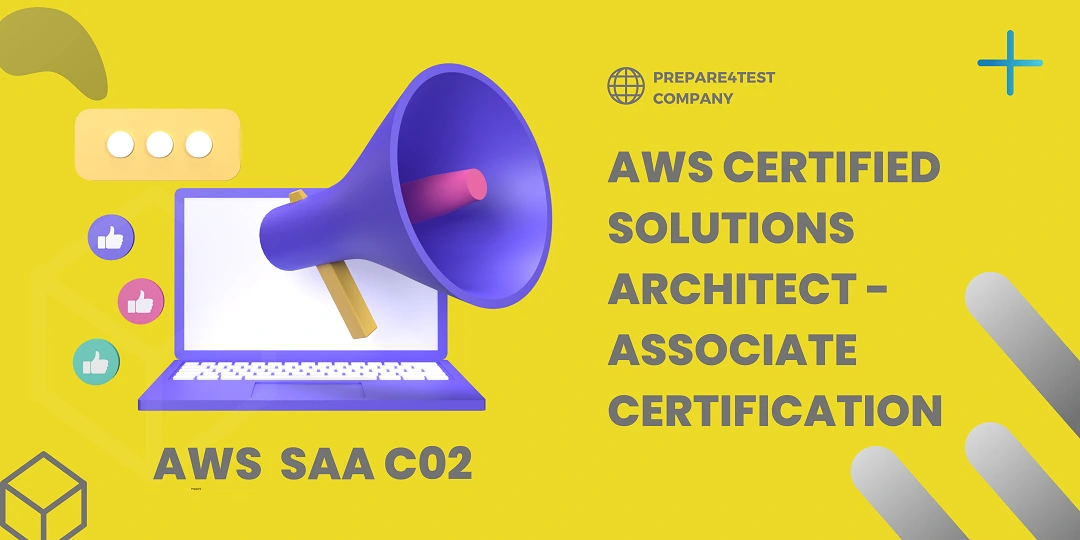
The AWS Certified Solutions Architect – Associate certification validates skills in designing distributed applications and systems on the AWS platform. This credential demonstrates expertise across a wide range of AWS services including compute, storage, databases, networking, security, and deployment. Architects certified in the AWS SAA C02 have the knowledge and skills to effectively demonstrate proficiency in choosing appropriate AWS services to design and deploy cloud-based solutions based on given requirements.
To prepare for the certification exam, it is recommended to study AWS whitepapers, take video courses from providers like A Cloud Guru, and use practice tests from companies like Whizlabs. Key concepts to focus on are EC2, S3, VPC, IAM, CloudWatch, Route 53, RDS, and serverless technologies like Lambda and DynamoDB.
The exam covers designing resilient, high-performing, secure, and cost-optimized architectures using the Well-Architected Framework. Tips for passing include taking practice exams, knowing AWS services and their use cases, and understanding core concepts like compute, storage, databases, networking, security, and monitoring.
Overall, the Solutions Architect – Associate certification validates critical skills in designing robust cloud solutions on AWS that are secure, highly available, and cost effective. Achieving this AWS SAA C02 credential can advance your career and demonstrate hands-on expertise working with key AWS services.
Overview of the AWS SAA C02 Exam
- Format: Multiple choice and multiple response questions
- Length: 130 minutes
- Domains:
Design Resilient Architectures (30%)
Designing resilient architectures involves building fault tolerant systems that can withstand component failures. This section covers 30% of the exam. Key concepts include deploying applications across multiple Availability Zones, implementing elastic load balancing, autoscaling groups, and database replication. Candidates should understand how to use AWS tools like CloudFormation to automate infrastructure deployments and create recovery plans. Focus on multi-tier architecture patterns, instance isolation using placement groups, decoupled architectures, and loose coupling. Architects must design solutions to mitigate and withstand failures to ensure high availability.
Define Performant Architectures (24%)
This section covers designing high-performing and scalable architectures which accounts for 24% of the exam. Key focus areas are compute, storage, databases, and networking. Architects should know strategies for selecting and deploying the optimal AWS services to meet performance requirements. Important concepts include autoscaling, load balancing, caching, decoupling, and distributed systems. Candidates must understand how to build architectures that can achieve fast performance, high throughput, and low latency while scaling to meet demand. The exam tests your ability to choose the right AWS building blocks that can deliver speed, efficiency, and elasticity for workloads.
Specify Secure Applications and Architectures (24%)
This section covers 24% of the exam and focuses on designing secure applications and architectures. Key areas include identity and access management, data protection, infrastructure security, detective controls, and compliance validation. Architects must know how to select appropriate AWS services to implement security controls and meet compliance requirements. Important concepts include managing identities, protecting data at rest and in transit, securing network traffic, logging/monitoring, encryption, and credential management. Candidates need to demonstrate expertise in building secure solutions on AWS that safeguard confidentiality, integrity, and availability.
Design Cost-Optimized Architectures (22%)
This domain covers 22% of the exam and focuses on selecting the most cost-effective AWS services to meet requirements. Architects should know strategies like right-sizing, autoscaling, purchasing reservations, spot instances, and serverless to reduce costs. Important concepts are analyzing spend, optimizing resource utilization, using managed services, evaluating pricing models, and cost/performance trade-offs. Candidates must demonstrate expertise in building solutions that minimize cost and maximize value on AWS. The key is selecting the most cost-efficient options for compute, storage, network, and databases to design architectures that are economical.
How to Prepare for the AWS SAA C02 Exam
Study Materials
The official exam guide from AWS is a key resource that provides an overview of the certification exam. It outlines the format, length, domains, and passing score for the exam. The guide also includes sample questions that demonstrate the style and rigor of the actual test questions. Reviewing the exam guide gives insights into the content areas covered and helps candidates understand the depth and complexity of questions asked. Using the official guide ensures you are studying the most accurate and up-to-date material straight from the source. It is an indispensable resource for comprehending the exam scope and preparing strategically.
AWS whitepapers
AWS publishes technical whitepapers that provide in-depth information on using AWS services and best practices for designing solutions on the cloud. These are authored by the AWS team and cover topics like architecture, security, operations, and economics. Reading whitepapers on core services like EC2, S3, VPC, IAM, and RDS provides foundational knowledge for the exam. Whitepapers also give insights into new capabilities and features of services. Reviewing relevant whitepapers ensures you are studying the most up-to-date information directly from the source. They serve as great learning resources for concepts assessed in the exam.
Video courses from A Cloud Guru, Linux Academy etc.
Video training courses from providers like A Cloud Guru and Linux Academy offer in-depth lessons on AWS concepts and services. These video courses teach through a combination of lectures, demos, labs, and practice tests. Following a structured video course helps learn key topics assessed in the exam like EC2, S3, VPC, IAM, and serverless. Courses also provide test taking strategies and sample questions to familiarize you with the exam format. Using video courses ensures you are getting the latest content and hands-on practice for passing the exam.
Practice exams from Whizlabs, Jon Bonso etc.
Taking practice exams from companies like Whizlabs and Jon Bonso provides a critical assessment of your AWS knowledge. These tests closely simulate the actual exam with similar question styles and rigor. Reviewing detailed explanations for both correct and incorrect answers reinforces concepts like EC2, S3, VPC, IAM, and serverless. Repeated practice with these tests identifies weak areas to focus further study on. Scoring over 90% on practice exams boosts confidence to pass the real exam. They are indispensable for gaining exam familiarity and expertise in key services assessed.
Key Concepts to Focus On
The Well-Architected Framework provides best practices for designing secure, reliable, performant, and cost-optimized architectures on AWS. It is organized into six pillars – operational excellence, security, reliability, performance efficiency, cost optimization, and sustainability. Understanding the principles and key concepts of the framework is essential for the exam, as you will need to demonstrate expertise in assessing architectures using the Well-Architected tool. The framework provides a consistent approach for evaluating solutions against cloud best practices.
Compute services: EC2, Lambda, ECS, EKS
Compute services like EC2, Lambda, ECS, and EKS are critical for deploying applications on AWS. EC2 provides virtual servers to run applications using various instance types. Lambda enables serverless functions that auto-scale. ECS manages Docker containers on AWS while EKS runs Kubernetes clusters. Understanding the use cases like scalability, cost, and automation is key for choosing the optimal compute option. Architects must know these core services to select the appropriate platform for a given workload.
Storage services: S3, EBS, EFS
Amazon S3 is a highly scalable object storage service used for content delivery, backups, and big data analytics. AWS EBS provides block storage volumes to provision storage for EC2 instances. Amazon EFS offers an elastic file storage system that can be accessed concurrently by thousands of EC2 instances. Understanding the use cases and performance characteristics of these core storage services is essential for choosing the optimal storage solution for a given workload. Architects must demonstrate expertise in S3, EBS, and EFS which are foundational AWS storage building blocks.
Database services: RDS, DynamoDB
Amazon RDS provides managed relational databases while DynamoDB offers fast NoSQL databases. RDS supports MySQL, PostgreSQL, Oracle, and SQL Server engines for traditional workloads like ERPs and e-commerce. DynamoDB handles high-velocity data for mobile, gaming, and IoT applications. Architects must know when to use RDS versus DynamoDB based on structure, relationships, queries, and scaling needs for the AWS SAA C02 exam. RDS excels at complex queries while DynamoDB rapidly ingests unstructured data. Both integrate with IAM and offer encryption, backups, and high availability across zones.
Networking services: VPC, Direct Connect, Route 53
Amazon VPC enables the provisioning of logically isolated networks on AWS. AWS Direct Connect provides dedicated network connectivity between on-premises sites and AWS. Amazon Route 53 offers highly available and scalable DNS web services. Understanding use cases like hybrid connectivity, traffic management, and private networks is essential to selecting the appropriate networking building blocks. Architects must demonstrate expertise in core networking services like VPC for isolation, Direct Connect for hybrid links, and Route 53 for DNS management.
Security services: IAM, KMS, CloudTrail, WAF
Identity and Access Management (IAM) enables access control through permissions policies and multi-factor authentication. AWS Key Management Service (KMS) allows creation and control of encryption keys. CloudTrail provides logging of API calls to monitor activity. Web Application Firewall (WAF) filters malicious web traffic to protect applications. Architects must know these core security services to implement access controls, protect data, monitor systems, and secure applications on AWS.
Monitoring: CloudWatch, X-Ray
CloudWatch provides metrics, logs, and alarms to monitor AWS resources and applications. X-Ray traces requests to identify performance issues and errors. Using CloudWatch metrics for resources like EC2 and S3 paired with X-Ray traces delivers an end-to-end view to isolate bottlenecks. CloudWatch Synthetics can monitor APIs and endpoints. Integrating X-Ray tracing with CloudWatch logs and metrics enables faster troubleshooting by correlating performance data. Architects should demonstrate expertise in using these tools together to gain observability across AWS environments.
Deployment: CloudFormation, Elastic Beanstalk
AWS CloudFormation provides infrastructure as code capabilities to provision AWS resources via templates. Elastic Beanstalk offers auto-scaling deployments of applications using platforms like Java, .NET, Node.js. CloudFormation can deploy Elastic Beanstalk environments, enabling full infrastructure and application management. Using them together provides a robust deployment pipeline – CloudFormation templates build foundational infrastructure while Beanstalk deploys and scales applications. Architects should know these core deployment services and their integration.
Tips for Passing the Exam
Taking practice exams from providers like Tutorials Dojo and Whizlabs is critical to benchmark AWS knowledge and identify gaps. Scoring low in certain domains highlights areas needing further focus. Use explanations for wrong answers to revisit services like SWF, Macie, and ML. Review use cases around niche technologies not covered deeply in courses. Practice tests replicating the exam format and complexity help assess readiness. Keep taking them until scoring over 90% to ensure you have addressed weak areas.
Review the Exam Guide and sample questions
The official exam guide from AWS provides sample questions that demonstrate the format and complexity of the real exam questions for the AWS SAA C02 exam. Reviewing these samples familiarizes you with the style of questions and available response types. The guide outlines the content domains like security, resilience, performance, and cost optimization covered in the exam. Studying the guide ensures you understand the weighting of each domain and can focus your preparation accordingly. Sample questions also highlight the practical nature of questions asked, testing your ability to choose the optimal AWS services and architectures based on specific requirements.
Know the various AWS services and their use cases
To pass the exam, architects must demonstrate an in-depth understanding of the key AWS services and their optimal use cases. This includes compute options like EC2, ECS, Lambda, databases like RDS and DynamoDB, storage with S3 and EFS, networking using VPC, Route 53 and Direct Connect, security through IAM, KMS, and WAF, and monitoring via CloudWatch and X-Ray. Knowing when to apply the right AWS building blocks based on factors like scalability, resilience, performance and cost is critical. The exam validates expertise in selecting appropriate services to meet technical and business requirements.
Understand how to design fault tolerant and cost optimized architectures
Architects must know strategies for building resilient and economical architectures on AWS. For fault tolerance, use multi-AZ deployments, implement elastic load balancing, decouple components, and automate healing. For cost optimization, right-size resources, choose reserved instances, use spot instances, and serverless where applicable. Follow the Well-Architected Framework pillars for reliability and cost optimization. The exam assesses your ability to select services and design patterns that maximize uptime and minimize spend.
Brush up on core concepts like EC2, S3, VPC, IAM
The exam covers foundational AWS services so reviewing core concepts is crucial. Know EC2 instance types, EBS volumes, auto scaling groups, and Elastic Load Balancers. Understand S3 storage classes, encryption, bucket policies, and lifecycle management. Study VPC and subnet basics, route tables, security groups, NAT Gateways, and VPC peering. Review IAM users, groups, roles, policies, and integrating with Active Directory. Revisit Well-Architected pillars for these services. Hands-on practice deploying them cements knowledge.
Conclusion
Preparing for the (AWS SAA C02) AWS Certified Solutions Architect – Associate exam requires dedication and using the right study resources. Start by reviewing the official exam guide and sample questions from AWS to understand the format, content areas, and complexity of questions. Study technical AWS whitepapers to gain in-depth knowledge on key services like EC2, S3, VPC, IAM, and RDS. Enroll in a structured video course to learn concepts and get hands-on practice through labs. Reinforce your learning by taking practice tests from providers like Whizlabs and Bonso until you can consistently score over 90%.
As you prepare, make sure to brush up on core AWS services and know when and how to apply them based on factors like performance, resilience, security, and cost. Focus on understanding how to design fault tolerant architectures that are also cost optimized. Refer to the Well-Architected Framework for reliability and cost optimization principles. Identify any weak areas through practice tests and revisit services you lack expertise in. With consistent preparation using updated official resources, you will gain the knowledge and skills required to pass the AWS Solutions Architect – Associate exam. The key is hands-on practice, taking mock tests, and learning AWS best practices for designing optimal cloud-based solutions.
